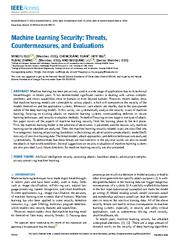A copy of this work was available on the public web and has been preserved in the Wayback Machine. The capture dates from 2020; you can also visit the original URL.
The file type is application/pdf.
Machine Learning Security: Threats, Countermeasures, and Evaluations
2020
IEEE Access
Machine learning has been pervasively used in a wide range of applications due to its technical breakthroughs in recent years. It has demonstrated significant success in dealing with various complex problems, and shows capabilities close to humans or even beyond humans. However, recent studies show that machine learning models are vulnerable to various attacks, which will compromise the security of the models themselves and the application systems. Moreover, such attacks are stealthy due to the
doi:10.1109/access.2020.2987435
fatcat:ksinvcvcdvavxkzyn7fmsa27ji

